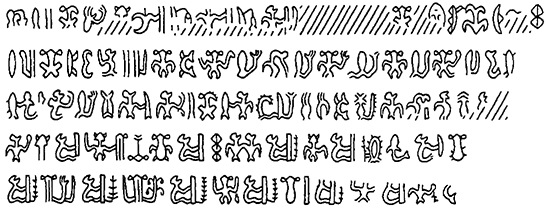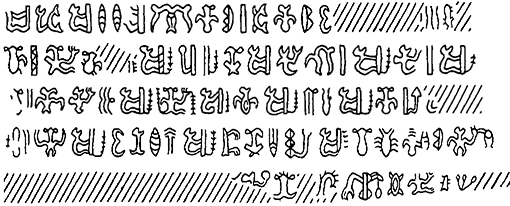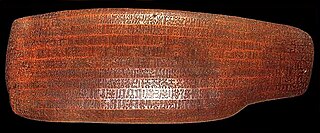
Rongorongo is a system of glyphs discovered in the 19th century on Easter Island that has the appearance of writing or proto-writing. Numerous attempts at decipherment have been made, but none have been successful. Although some calendrical and what might prove to be genealogical information has been identified, none of the glyphs can actually be read. If rongorongo does prove to be writing and to be an independent invention, it would be one of very few inventions of writing in human history.
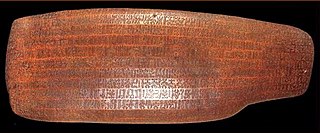
Rongorongo is a system of glyphs discovered in the 19th century on Easter Island that appears to be writing or proto-writing. Text B of the rongorongo corpus, also known as Aruku Kurenga, is one of two dozen surviving rongorongo texts.
Text C of the rongorongo corpus, also known as Mamari, is one of two dozen surviving rongorongo texts. It contains the Rapa Nui calendar.

Rongorongo is a system of glyphs discovered in the 19th century on Easter Island that appears to be writing or proto-writing. Text D of the rongorongo corpus, also known as Échancrée ("notched"), is one of two dozen surviving texts. This is the tablet that started Jaussen's collection.

Rongorongo is a system of glyphs discovered in the 19th century on Easter Island that appears to be writing or proto-writing. Text E of the rongorongo corpus, also known as Keiti, is one of two dozen known rongorongo texts, though it survives only in photographs and rubbings.
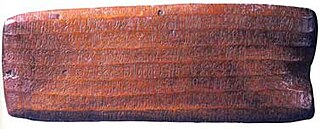
Text G of the rongorongo corpus, the smaller of two tablets located in Santiago and therefore also known as the Small Santiago tablet, is one of two dozen surviving rongorongo texts. It may include a short genealogy.

Text H of the rongorongo corpus, the larger of two tablets located in Santiago and therefore also known as the Great or Large Santiago tablet, is one of two dozen surviving rongorongo texts, and one of three recording the so-called "Grand Tradition".
Text N of the rongorongo corpus, the smaller of two tablets in Vienna and therefore also known as the Small Vienna tablet, is one of two dozen surviving rongorongo texts. It repeats much of the verso of tablet E.
Text Q of the rongorongo corpus, the smaller of two tablets in St. Petersburg and therefore also known as the Small St Petersburg tablet, is one of two dozen surviving rongorongo texts, and one of three recording the so-called "Grand Tradition".
Text P of the rongorongo corpus, the larger of two tablets in St. Petersburg and therefore also known as the Great or Large St Petersburg tablet, is one of two dozen surviving rongorongo texts, and one of three recording the so-called "Grand Tradition".

Text S of the rongorongo corpus, the larger of two tablets in Washington and therefore also known as the Great or Large Washington tablet, is one of two dozen surviving rongorongo texts.

Rongorongo is a system of glyphs discovered in the 19th century on Easter Island that appears to be writing or proto-writing. Text F of the rongorongo corpus, also known as the (Stephen) Chauvet tablet, is one of two dozen surviving texts.
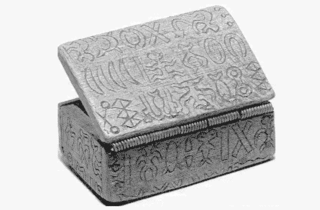
Text Y of the rongorongo corpus, known as the Paris Snuff Box, is one of two dozen surviving rongorongo texts.
Text T of the rongorongo corpus, also known as Honolulu tablet 1 or Honolulu 3629, is the only fluted tablet in the Honolulu collection and one of two dozen surviving rongorongo texts.
Text U of the rongorongo corpus, carved on a beam, also known as Honolulu tablet 2 or Honolulu 3628, is one of two dozen surviving rongorongo texts.
Text V of the rongorongo corpus, the Honolulu oar, also known as Honolulu tablet 3 or Honolulu 3622, may be one of two dozen surviving rongorongo texts. Its authenticity has been questioned.

Text Z of the rongorongo corpus, also known as Poike, is a palimpsest inscription that may be one of two dozen surviving rongorongo texts. The authenticity of the upper text is in question.

Text L of the rongorongo corpus, also known as (London) reimiro 2, is the smaller of two inscribed reimiro in London and one of two dozen surviving rongorongo texts.
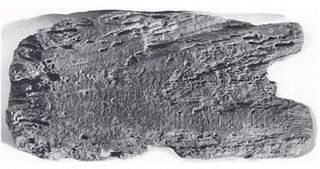
Text M of the rongorongo corpus, the larger of two tablets in Vienna and therefore also known as the Large or Great Vienna tablet, is one of two dozen surviving rongorongo texts.

There have been numerous attempts to decipher the rongorongo script of Easter Island since its discovery in the late nineteenth century. As with most undeciphered scripts, many of the proposals have been fanciful. Apart from a portion of one tablet which has been shown to deal with a lunar calendar, none of the texts are understood, and even the calendar cannot actually be read. The evidence is weak that rongorongo directly represents the Rapa Nui language – that is, that it is a true writing system – and oral accounts report that experts in one category of tablet were unable to read other tablets, suggesting either that rongorongo is not a unified system, or that it is proto-writing that requires the reader to already know the text. Assuming that rongorongo is writing, there are three serious obstacles to decipherment: the small number of remaining texts, comprising only 15,000 legible glyphs; the lack of context in which to interpret the texts, such as illustrations or parallel texts which can be read; and the fact that the modern Rapa Nui language is heavily mixed with Tahitian and is unlikely to closely reflect the language of the tablets—especially if they record a specialized register such as incantations—while the few remaining examples of the old language are heavily restricted in genre and may not correspond well to the tablets either.
